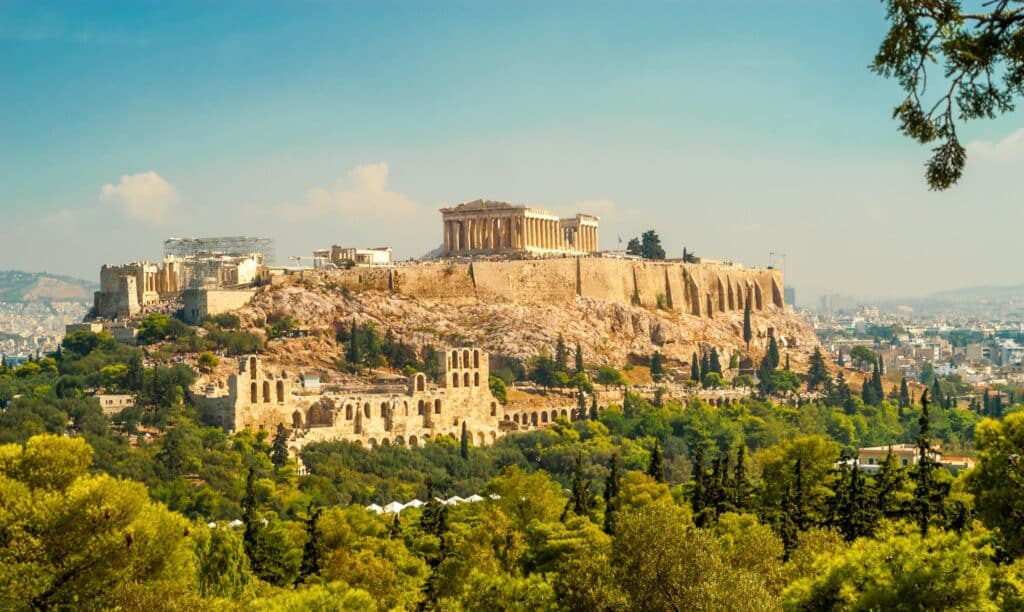
The Acropolis’s entry fee is €30 for adults as of 2025 (tickets are half-price at €15 during the winter off-season). This price includes access to the archaeological site on the hill and its slopes, where you can roam among ancient ruins. Reduced admission (€15 in summer) is available for eligible visitors such as seniors and students, and children (especially EU residents under 25) can enter free.
You can buy tickets at the entrance or online in advance – some guided tours of Athens also include Acropolis admission as part of the package. The site opens at 8:00 AM daily, with closing time varying by season: during the long summer days (April through August) it stays open until about 8:00 PM, whereas in the winter months it closes around 5:00 PM (last entry is usually 30 minutes before closing). We visited on 3 September 2025, and all the details were valid as of that date.
Exploring the Acropolis: History and Highlights
You might wonder if the steep climb up the Acropolis is worth it – we believe it absolutely is, and here’s why. Stepping through the Propylaea, the monumental gateway, felt like walking into a time capsule of classical history.
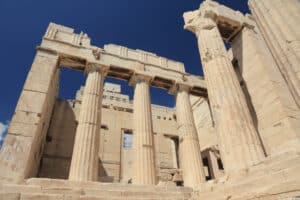
Propylaea entrance, monumental gateway to the Acropolis
The Acropolis of Athens is one of the world’s most iconic archaeological sites, a rocky hill crowned by marble temples that have stood for nearly 2.500 years.Its most famous monument, the Parthenon, dominates the plateau with imposing Doric columns that once enclosed a colossal statue of Athena. Although the Parthenon is a ruin today (it lost its roof in a 17th-century explosion and has weathered countless storms since), its elegance and scale are still breathtaking. We found ourselves marveling at how this temple, built in 5th century BC during Athens’s golden age, still presides over the city. Its no surprise the Acropolis is recognized as a UNESCO World Heritage Site – it’s literally the birthplace of ideas like democracy, drama, and philosophy. As we stood among the stones, we imagined the grand festivals and processions that took place here in ancient times, and we felt the weight of history in every direction.
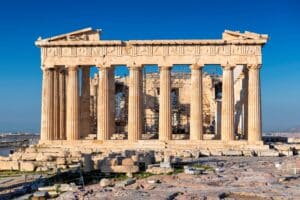
Parthenon, Doric columns on the Acropolis plateau
What also struck us about the Acropolis was the intricate detail and variety of its structures. To the north of the Parthenon stands the Erechtheion, an elegant temple on the sacred spot where Athena and Poseidon were said to have competed for the city’s favor. The Erechtheion’s most famous feature is the Porch of the Caryatids: six graceful maiden statues that serve as columns supporting the roof. We were particularly impressed by these figures – even though the ones you see outside are replicas (the originals are safely preserved in a museum), their serene faces and draped robes are incredible to behold up close. At the southwest edge of the complex, you can spot the tiny Temple of Athena Nike perched by the entrance, a tribute to Athena as the goddess of victory. And don’t dont miss looking down the southern slope: from the top we could see the ancient Theatre of Dionysus fan out below, the very place where Athenians once premiered the plays of Sophocles and Euripides over two millennia ago. It’s amazing to realize that this one hill hosted both sacred temples and the cradle of theatre and the arts.
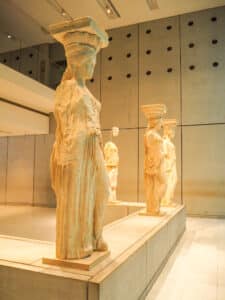
Caryatids in the Acropolis Museum, interior view
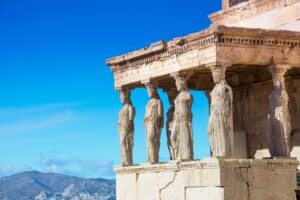
Karyatides statues, Erehtheio, on the Acropolis in Athens, Greece.
Visiting the Acropolis is not just about admiring old stones – it’s about the atmosphere and the views as well. We suggest wearing sturdy shoes on the uneven limestone and marble paths – the rock underfoot is smooth and can be slippery – and in summer, don’t forget a hat and water since there’s not much shade up there.
The hilltop is completely exposed to the elements, which meant that when we visited on a sunny afternoon, we were grateful for a breeze and some sunscreen. The reward for the climb is a panoramic vista of Athens spread out below. From the edge of the Acropolis, we gazed out at the modern city and could pick out landmarks like Mount Lycabettus and the distant Aegean Sea gleaming on the horizon. If you’re wondering how long to stay, we’d recommend allocating at least a couple of hours for the Acropolis itself. We spent roughly two hours exploring the summit – walking around the Parthenon’s perimeter, peering into ancient storerooms, and taking plenty of photos – and we easily could have lingered longer. To beat the rush, we decided to go in the late afternoon, and it turned out to be a great choice. There were fewer tour groups crowding the pathways, and the lowering sun gave the marble buildings a golden glow that felt almost magical. By the time we were making our way down, the city lights were starting to twinkle, and we knew our effort to climb this legendary hill had absolutely been worth it.
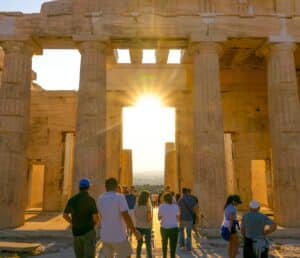
Acropolis Entrance Fee – Entrance Portico to the Athenian Parthenon at Sunset
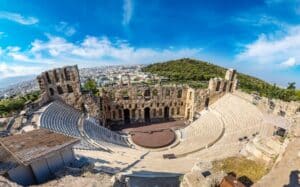
Ancient theater in a summer day in Acropolis Greece, Athens
Beyond the Acropolis: Nearby Attractions and Where to Unwind
After your Acropolis visit, there’s plenty more to explore nearby. Just southeast of the hill (a two-minute walk from the exit) stands the Acropolis Museum, a must-see modern museum that brilliantly complements the ancient site. We headed there next and found it the perfect way to deepen our understanding of what we’d just seen on the Acropolis.
Inside this sleek museum, you can see the original sculptures and treasures that once adorned the hill’s temples. We were amazed to come face-to-face with the actual Caryatid statues from the Erechtheion – the museum displays them in pristine condition, which really lets you appreciate their craftsmanship (one missing sister is still in the British Museum in London). The museum’s top floor also houses the Parthenon Frieze and other carvings, thoughtfully arranged in the same layout as they were on the Parthenon itself. As we walked through, we felt like we were piecing together the stories of the Acropolis in a comfortable, air-conditioned gallery – a nice change after the hot sun outside. Even if you’re not usually a museum person, we’d highly recommend this one because it brings the Acropolis to life. Plus, the café terrace there offers a fantastic view back up at the Parthenon, so you can relax with a cold drink while gazing at the very monument you just explored.

Acropolis Museum exterior on Dionysiou Areopagitou Street
To continue your journey through ancient Athens, a short stroll north from the Acropolis will lead you to the Ancient Agora, the old public square and heart of the city in classical times. Walking through the Agora’s ruins felt like stepping into the daily life of Socrates and Plato. We wandered among the remnants of stoas (covered walkways) and government buildings, and especially loved the Temple of Hephaestus, which stands on a small hill at the Agora’s edge. That temple is remarkably well-preserved – its columns and roof are almost intact, so much so that it looks like a smaller cousin of the Parthenon. It’s a peaceful spot where we paused under the portico’s shade, imagining philosophers debating in the marketplace that once sprawled here. If you’re interested in ancient history, you shouldn’t miss the Agora Museum as well (housed in the restored Stoa of Attalos within the site), where everyday objects and pottery bring to life how the Athenians lived. The Agora is included in some multi-site ticket packages for Athens, but even if you visit separately, it’s worth the modest entry fee and the short walk from the Acropolis to see another side of the ancient city.
Once we had our fill of ruins and history, we were ready to unwind and talk about all we had seen. Luckily, the area around the Acropolis is full of charming places to eat and relax. We wandered into the Plaka neighborhood, a historic district with narrow winding streets just at the foot of the Acropolis, and found a lovely traditional taverna called To Kafeneio. This family-run restaurant was the perfect spot for us to rest our feet and enjoy a late Greek lunch. We highly recommend their moussaka – it came out piping hot, layered with eggplant and spiced meat, topped with creamy béchamel, and it tasted heavenly after a long morning of walking. We also couldn’t resist ordering a round of ice-cold frappés (the famous Greek iced coffee), which gave us a much-needed jolt of energy. Sitting there in the shady courtyard, clinking glasses and enjoying the home-cooked food, was a delightful break. We noticed a mix of locals and tourists around us, and a friendly waiter even taught us a few Greek phrases. It was one of those simple travel moments that feels really authentic.
If you still have some energy (and room in your belly) after lunch, we suggest taking a leisurely stroll around the neighborhood or even up a nearby hill for one more unforgettable view. Just west of the Acropolis lies Areopagus Hill (also known as Mars Hill), a big outcrop of rock that you can climb via a short set of stairs. We scrambled up in the early evening and found ourselves on a rocky platform where locals and visitors alike were gathering to watch the sunset. From atop Areopagus, the view is breathtaking: the Acropolis rises immediately beside you, so close that you can see the Parthenon’s columns silhouetted against the sky, and the city of Athens stretches out in all directions below. As the sun went down, the marble temples on the Acropolis started to glow in the warm light, and eventually the floodlights came on, bathing the Parthenon in golden illumination. It was a peaceful, awe-inspiring end to our day. In fact, sitting up there on Areopagus Hill, we realized it was the perfect spot to reflect on everything we’d experienced – from walking in the footsteps of Pericles and Phidias to enjoying modern Greek hospitality in Plaka. We left as the stars began to appear, tired but exhilarated, with the Acropolis shining above us. Whether you’re a history enthusiast or just a traveler looking for a beautiful view, visiting the Acropolis is an experience we believe every visitor to Athens will cherish – it certainly left us with memories we’ll treasure for years.

